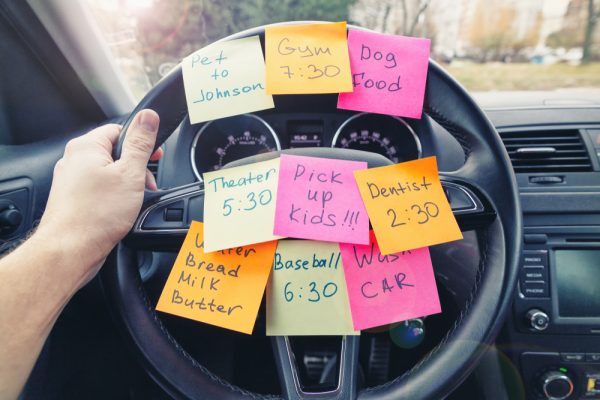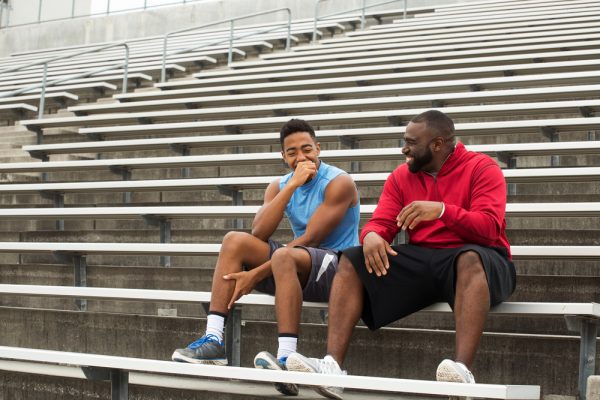
When we ask parents about the obstacles they face in having regular family dinners, busy schedules usually top the list. One of the common culprits jamming the family calendar is kid sports. Starting at increasingly younger ages, children are taking part in athletic programs that quickly seem to eat up the family dinner hour.
What can parents do to balance kid sports and family dinner?
We talked to Dr. Stephen Durant, co-founder and co-director of the Massachusetts General Hospital Sports Psychology Program and co-author of the book Whose Game is it Anyway? As an athlete himself, as well as a father and grandfather, Durant has a wealth of both personal and professional experience in integrating sports and family life. Here’s what he had to say about finding the balance.
First, think about why your child is participating in sports.
Youth sports have become so popular that for many parents, it’s easy to take for granted that children “should” or “must” participate as much as possible. But Durant advises keeping the big picture in mind. “The big picture, for kids ages 0-6, is the joy of movement,” he says. “For kids from 6-12, it’s fun, friends, and fitness.”
That means that for younger kids especially, organized sports don’t have to be at the top of the list. “Whatever you’re doing for sports in 6 and unders, it should be just for enjoyment,” Durant counsels. “It’s swimming at the pool or the beach, rolling in the sand.” The joy of movement for younger children can be found at neighborhood playgrounds, in a game of backyard tag, or learning to ride bikes and scooters. And if a child doesn’t enjoy the activity, then it’s not worthwhile – which may be encouraging for parents of the kids who are more likely to pick daisies in left field than look forward to T-ball practice.
As kids get a bit older, Durant says the focus on “fun, friends, and fitness” should be the primary motivation for enrolling in sports. Although there are “elite” teams, extra clinics, and other add-on activities offered to kids under 12 who show potential, Durant cautions parents that early specialization isn’t always a good idea.
“My own opinion is that (a promising baseball player) is better off playing catch with his dad and enjoying it,” he says. “A lot of the pros I see played multiple sports. Up until age 12, you’re better off trying a lot of things, including music and other non-athletic activities. You want to be careful about limiting kids and running the risk of overuse injuries.”
Once young athletes are in their teens, Durant encourages parents to help them take a broad view of the role of sports in their lives. “It’s about identity consolidation and formation,” he says. “From a sports perspective, even in the pros, I say ‘God may have made you to be a hockey player, but that’s not the only thing he made you.’ You have to develop other aspects of identity, because you won’t play sports forever.”
He adds that when a teen’s life revolves too heavily around sports – especially a single, specific sport – it can lead to potential mental health issues when and if that sport is no longer an option. “I get a lot of injured high school athletes with anxiety and fear when they’ve lost their sport due to cardiac issues or serious injuries,” he says. “Parents need to help kids think about: How do you build other aspects of your personality, not become a one trick pony?”

Consider how the sport aligns with your family values.
Looking back on his experience as the parent of four children, Durant recalls the push-and-pull between the kind of family life he and his spouse envisioned, his kids’ schedules, and the external pressures from peers and coaches – and he says that now, as a grandfather, he can see those challenges have only intensified. “Obviously, if we’re talking about family dinners, they’re greatly challenged by sports. We’ve got 5 o’clock, 6 o’clock practices, dancing, swimming, blah, blah, blah,” he lists. But that race to get everyone to practice and games, although popular among other families in your area, may not be what’s ultimately best for your family unit.
“Every family has to figure out, what are the values we’re trying to pass on through sport?” Durant advises. He points out that many families will focus on possible outcomes like college athletics scholarships, admissions advantages, and pro careers – all of which Durant discourages as motivating factors. “I would caution people against outcome-based goals, and more towards fun, fitness, friends, and the values of the family. Parents have to talk about it and come to some agreement, but it could be that you want to emphasize commitment. Or you may want to emphasize fitness, or friendship, or skill building, or courage. There’s plenty to choose from and they’re all good, but if you don’t stop and think about what you’re trying to do, the nature of youth sports is like a raging river.”
He gives the example of summer hockey leagues. “Your oldest kid starts out in hockey, and the parents make friendships. And the kid makes the A team, and you want to stay in, so you gotta play summer hockey!” That kind of progression in youth sports may feel “natural” to families, but again, Durant cautions that it can also be a sign of getting swept up in a culture that isn’t necessary or balanced. “A lot of times, things will be driven by the most ambitious family with the best athlete,” he points out. “They’ll set the tone for everyone. But that may not be in your family’s best interests.”
If the activity is keeping you from enjoying time as a family, it may be time to re-evaluate. Durant looks back at his own family’s experience with the summer hockey league and remembers thinking, “What the **** are we doing? It’s 85 out!” He laughs. “By the third kid it was like, ‘This is nuts! We’re going to the beach.’”

Know your kid, know yourself, know the program.
When asked for his best advice to parents who are trying to find balance in the tricky world of kid sports vs. family life, Durant doesn’t hesitate. “Know your kid, know yourself, know the program,” he says.
Again drawing on his own experience as a parent, Durant shares a story about his eldest son. When his son was a freshman in high school, he told Durant he didn’t want to play hockey anymore. “I was gutted,” Durant says. “I loved watching him play hockey. And then I talked to him and I realized the hockey thing was me, not him. So I started playing adult league hockey. I was like, ‘Look, if it’s about you, play Tuesday night hockey instead of forcing your son to play because you love hockey. You gotta get out of the kid’s way.”
He says this kind of experience is illustrative of what many parents may be dealing with, but may not recognize within themselves. “It was more about my unresolved issues, because I wished I had played high school hockey,” he says. He counsels parents to ask themselves, “What am I getting out of my kids playing this sport?” And, he says, if you have a partner, ask them to help you understand your role in your child’s athletic participation – and help you step back as needed. “Work with your spouse,” he advises. “Say, ‘You gotta hold my feet to the fire on this.’”
Durant adds that it can be difficult for parents to do the right thing when it comes to youth sports, because they not only have to know themselves and regulate their own emotions, but they have to understand their individual children and how the sports programs work for them. “I think the best way to measure a good program is how many kids return to play, and how many kids quit – and how happy is your child within a program?” he says. “But as kids get older, I think they tolerate more frustration and more unhappiness, so you have to know your kid.” What might seem like “tough coaching” to a parent may not be in their child’s best interests, and may not even be developmentally appropriate.
“One of the crucial things to remember,” Durant cautions, “is that children are not mini adults. You cannot impose adult coaching onto kids under 14, at least. I’ll give an example. Let’s say you’re a Pop Warner coach and you’ve got a quarterback who’s 10 years old. Kids that age have a hard time with the auditory memory to recall a 10 digit phone number, so under stress, if you’re yelling a long play to a kid you’re asking him to do something his brain is not equipped for yet. It’s the same reason why they stopped checking in youth hockey, because of dynamic visual acuity and your ability to judge time and space and brace yourself to protect yourself from a brain jostling hit.”
And it’s not just coaches who may intrude on a child’s ability to enjoy sports. “The father behind the backstop yelling at the Little League kid at bat – all you’re doing is triggering ‘red brain’ for that kid, making him anxious and distracting him and making it not fun. You’re intruding on a process that is going to make the kid not enjoy what they’re doing.”
Ultimately, if parents have the sense that the current sport or program isn’t working well for their child and family, Durant encourages them to step away and try something new. “If you know your kid tends to be more introverted or likes more control, maybe you steer them towards a more individual sport, or drama, or music. A more extroverted kid may need soccer or another sport where they can run their *** off all the time.” The bottom line, he says, is that sports only work well for kids and families when they’re enjoyable and contributing to overall well-being.

Set up structured family time that works for everyone.
No matter what kids want to do, it’s an adult responsibility to manage the family’s schedule and ensure there’s time for balance and connection. Durant recommends having a rule about participation that the whole family can stick to. “When you have four kids, it’s like riot police,” he jokes. “All hands on deck, and by the last kid, it’s a free-for-all.”
To keep the schedule manageable, the Durant family rule was one sport per child per season, plus one other activity. “I’m a big believer in the diversity of what activities you’re doing,” Durant says. “So you could have like one sport per season, plus piano lessons, or something.”
Even with a family limitation on the number of commitments per child, finding space in the schedule for family dinners can be challenging. Most parents are familiar with Little League schedules that demand three or more days per week of practices and games, or swim team calendars that have kids in the pool more than they’re home. That’s where Durant advises that parents get both creative and intentional about carving out space for connection.
Citing his family’s background in both the Catholic and Quaker faith traditions, he says they mandated “Quiet Time” together every Sunday evening. “We’d all just sit in silence and then starting with the youngest kid, each person would say a spontaneous prayer. Then we’d organize the week. Okay, you’ve got dance, you’ve got gymnastics, what have you got? You could tell the weeks where we missed quiet time. The family would start to spin out of control a little bit. We weren’t grounded,” he says.
The Durants’ “quiet time” happened outside of the dinner hour, but families can adapt the idea to have the same kind of gathering during a once-a-week meal together – whether it’s dinner, breakfast, or a weekend lunch. This type of check-in and grounding time together could also happen in shorter increments a few times a week, over a post-practice snack or a late evening family dessert. The goal is really to ensure that youth sports don’t overtake quality time together.
“If mealtime gets compromised,” Durant says, “You want to then pay extra attention to transition times, like when the kids go to bed. Talk to them. If you’re a prayerful family, pray with them. Read to the little kids. But if you can’t have dinner together, at least spend that time.” He also mentions gratitude as a “primary virtue” he discusses with all athletes, including his professional clients. “Twenty minutes a day of gratitude-based meditation changes the brain,” he says. Building in a practice of gratitude – even just a short reflection on what each person is thankful for – during your structured family time can help you make the most of your minutes together.
For Durant, quality time also includes full presence and eye contact. When asked about the common response “Well, we talk in the car on the way to and from practice,” he brings up research on the neurological effects of eye contact. “I tell parents to make a commitment. For the first 30-60 seconds when you go over the threshold and you talk to your partner, pay total attention to them and put your eyes on them,” he says. “Same for the kids. Sixty seconds. Make that visual contact. That’s a serotonin thing, an oxytocin thing, a bonding thing. It changes your brain chemistry. Slow down. Build in that quiet.”
Looking back, Durant says there’s one thing he wishes he had done more of as a parent to young athletes. “Another hockey parent I knew would make a date with each child. He’d rotate weeks, and it would be, like, ‘Jackie, this is your week. What should we do?’ I wish I had done that more. I think if you have some kind of system like that, and you stick to it, maybe you don’t have to go to every game and every practice.” He points out that often, the youth sports schedule is made more grueling for families by parents’ insistence on constantly being on the sidelines, possibly with siblings in tow. Having rituals and routines that prioritize uninterrupted connection, either one-on-one or as a group, can be more impactful than being at the field for every minute of practice.
The Bottom Line
Balancing kid sports schedules and family dinner comes down to understanding your family’s goals, priorities, and needs – and knowing when to step away or say “no.” Although it can be tempting to fall into the trap of believing that the extra baseball pitching clinic, private swim coaching session, or soccer travel team opportunity will change your child’s life, Durant looks at things a bit differently.
“There’s a chance your kid is the next Wayne Gretzky,” he says, “but it’s a small chance.” Participating in sports should be a foundational experience that adds to your child’s sense of self and overall well-being, both physically and emotionally. But the first and best place for a child to experience belonging and a sense of identity isn’t on the field – it’s at home. Setting a foundation of family time and connective rituals, especially shared meals and moments of gratitude, will support your young athletes in every aspect of their lives.
